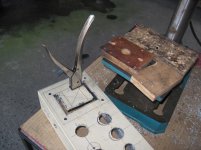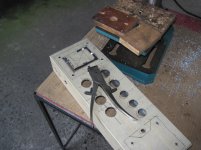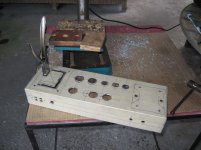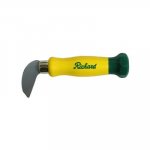Or buy my boxes finished from China and save my self all the hassle . I have a smaller cabinet i order for test. 17x29x6cm for 50$ incl shipping.
I do have a 6" guillotine in my shop. But it bend the plate so much I find it useless for other than bolt clipping, - where I rather use hand saw or Dremel for cleaner cut.
hmmm.. maybe I can try the guillotine to just trim the edges. Never thought about that. That might actually work out OK. I invested in the guillotine long time ago for the purpose cutting sheet metal. But was so disappointed by my result that its just stayed there collecting dust. I'll give it a try this weekend and let you know.
I do have a 6" guillotine in my shop. But it bend the plate so much I find it useless for other than bolt clipping, - where I rather use hand saw or Dremel for cleaner cut.
hmmm.. maybe I can try the guillotine to just trim the edges. Never thought about that. That might actually work out OK. I invested in the guillotine long time ago for the purpose cutting sheet metal. But was so disappointed by my result that its just stayed there collecting dust. I'll give it a try this weekend and let you know.
A plasma cutter would make quick work of sheet steel. But, I'd try the circular saw (Skilsaw) with an abrasive cutting disc. If the Skilsaw wears out, it's easy to find another one at a garage sale or thrift store for under $10.
Since a router can make very straight and precise cuts in wood, I've been tempted to try using a carbide bit on metal. The main fear is of metal fragments getting into the motor, and used routers are much less common than saws. An electric die grinder typically has a long shaft so the motor is safely away from the business end, but I'd have to make a router base to hold it perpendicular. For small jobs on aluminum, a Dremel with a router base might be OK.
Finally, one other idea occurred to me: trim the sheet edgewise. Make a rough cut with the jigsaw or abrasive wheel, then clamp the sheet to the side of a stray speaker cabinet or whatever. Raise the router slightly above the surface (1/4" MDF?) and use the bottom of the cutter to trim the metal. I used the same method to trim box sides and dowel plugs before I got a flush cutting bit. It should make clamping the sheet metal much easier, since clamps won't get in the way of the router.
Since a router can make very straight and precise cuts in wood, I've been tempted to try using a carbide bit on metal. The main fear is of metal fragments getting into the motor, and used routers are much less common than saws. An electric die grinder typically has a long shaft so the motor is safely away from the business end, but I'd have to make a router base to hold it perpendicular. For small jobs on aluminum, a Dremel with a router base might be OK.
Finally, one other idea occurred to me: trim the sheet edgewise. Make a rough cut with the jigsaw or abrasive wheel, then clamp the sheet to the side of a stray speaker cabinet or whatever. Raise the router slightly above the surface (1/4" MDF?) and use the bottom of the cutter to trim the metal. I used the same method to trim box sides and dowel plugs before I got a flush cutting bit. It should make clamping the sheet metal much easier, since clamps won't get in the way of the router.
The problem with the jig saw is your pushing too hard. Slow and easy, you may need to twist your saw a small amount to off set the way it wants to drift.
I prefer a thin line of oil to keep the blade cool and to slow down some of the flying chunks of metal.
The best way as suggested earlier would be a shear at a sheet metal shop.
They make electric shears that cut up to 14 gauge steel, 2 negatives is 1/4" waste and a tendency to curl thinner metals (the shears cut fiberglass too). Do not cut any welds with these unless you like changing blades.
I prefer a thin line of oil to keep the blade cool and to slow down some of the flying chunks of metal.
The best way as suggested earlier would be a shear at a sheet metal shop.
They make electric shears that cut up to 14 gauge steel, 2 negatives is 1/4" waste and a tendency to curl thinner metals (the shears cut fiberglass too). Do not cut any welds with these unless you like changing blades.
For steel I use my jig saw and fine metal cutting blades from Germany. Most of the steel I use, however, is scrap from some piece of electronics equipment being repurposed.
We're fortunate that the US has a very active marketplace in used machinery -- I have a deep throated metal shear on my list. I think that shears put a lot of stress on Fiberglas however -- fine pcb traces can get damaged.
We're fortunate that the US has a very active marketplace in used machinery -- I have a deep throated metal shear on my list. I think that shears put a lot of stress on Fiberglas however -- fine pcb traces can get damaged.
I was referring to electric hand shears like these
18 Gauge Electric Sheet Metal Shears | Electric Metal-Cutting Shears ? Eastwood
That is what they use to cut fiberglass panels you see in restrooms.
I use these
Shop Wiss 3-1/4-in Carbon Steel Snips at Lowes.com
I see no reason to cut PCB boards with traces.
18 Gauge Electric Sheet Metal Shears | Electric Metal-Cutting Shears ? Eastwood
That is what they use to cut fiberglass panels you see in restrooms.
I use these
Shop Wiss 3-1/4-in Carbon Steel Snips at Lowes.com
I see no reason to cut PCB boards with traces.
I see no reason to cut PCB boards with traces.
Many PCBs are "panelized" for economy, then divided
Many PCBs are "panelized" for economy, then divided
OK now I understand, for that I would probably use my dremel mounted in its "drill press" holder.
One of my favourite tools for sheet is the Wiss supershear (similar shown here). they're similar to snips or aviation shears but effectively have three blades so cut out a thin strip of material without distorting the sheet at all ...a bit like a hand powered nibbler (in fact I have an Hitchi CN16, but invariably pick up the Wiss for most jobs). They go through 1.2mm (18swg) steel with ease, and should do 1.5mm, or thicker if your cutting aluminium. They're also handy for irregular shapes ...notching corners for trays etc.
For just making straight (or longer curved) cuts you could consider a bench mounted throatless shear.The type that uses a wheel cutter (like this). You can pick up the basic versions for practically nothing.
For just making straight (or longer curved) cuts you could consider a bench mounted throatless shear.The type that uses a wheel cutter (like this). You can pick up the basic versions for practically nothing.
Ok, so the guillotine exercise did not unveil anything new to me. It still warp the steel plate far too much for my liking. Even when only trimming the edge.
Ended up using the battery powered jigsaw. Freehand and very slow. Forget about laser guide as I had to angle the saw some 2-4 degree on the line to make it go somewhat strait.
Then I used the angle grinder with a grind disc to take the cut closer to the line before finishing with a hand file.
6 minute job with the right tool (hydraulic guillotine) to most of the Sunday to finish.
Regarding battery operated jig saw. They have plenty of power for this kind of jobs. Just stay clear of the model in the picture from my first post. I’m on my second one, and even this one is on its way back to the dealer again. On my fist jigsaw the laser stopped working. This one drain the battery even when not in use. Blade guide has way to much play and finally, laser is not aligned correctly. And I’m very tempted to say this tool is designed by morons whom never used a jig saw. The shield meant to protect you from stray bits and dust are made from yellow translucent plastic. Very hard to look through so you end up removing the protection glass. ...but I didn't say that out load, did I?
Ended up using the battery powered jigsaw. Freehand and very slow. Forget about laser guide as I had to angle the saw some 2-4 degree on the line to make it go somewhat strait.
Then I used the angle grinder with a grind disc to take the cut closer to the line before finishing with a hand file.
6 minute job with the right tool (hydraulic guillotine) to most of the Sunday to finish.
An externally hosted image should be here but it was not working when we last tested it.
Regarding battery operated jig saw. They have plenty of power for this kind of jobs. Just stay clear of the model in the picture from my first post. I’m on my second one, and even this one is on its way back to the dealer again. On my fist jigsaw the laser stopped working. This one drain the battery even when not in use. Blade guide has way to much play and finally, laser is not aligned correctly. And I’m very tempted to say this tool is designed by morons whom never used a jig saw. The shield meant to protect you from stray bits and dust are made from yellow translucent plastic. Very hard to look through so you end up removing the protection glass. ...but I didn't say that out load, did I?
Last edited:
For centuries, craftsmen used hand tools, because there was no electricity. They still made precision cuts in all kind of materials. Today, we take it for granted that we need a power tool to make even the most trivial cut.
For many years, I've been using a simple carbide tipped laminate cutter (see attachment) and a straight edge for cutting sheet metal and printed circuit boards. If you consider all the set up time required for power tools, I believe that using the laminate cutter is just as fast, and less prone screw-ups. (It certainly doesn't wander.)
For many years, I've been using a simple carbide tipped laminate cutter (see attachment) and a straight edge for cutting sheet metal and printed circuit boards. If you consider all the set up time required for power tools, I believe that using the laminate cutter is just as fast, and less prone screw-ups. (It certainly doesn't wander.)
Attachments
For many years, I've been using a simple carbide tipped laminate cutter (see attachment) and a straight edge for cutting sheet metal and printed circuit boards. If you consider all the set up time required for power tools, I believe that using the laminate cutter is just as fast, and less prone screw-ups. (It certainly doesn't wander.)
How thick can the sheet metal be? Got to get one to try...
Depending on how much cutting you need, and if you are only doing "straight cuts".....and your proximity to a metal/machinist/air conditioning shop.....it would be best to use a professional metal brake to shear your panels.
I have access to a shop that has a ten foot (about 3 meter) long metal shear, and I've used it to cut 1/4" thick aluminum panels, "like butter". Perfectly straight, clean cuts. Although the shear is HUGE, its extremely accurate (to 1/1000 of an inch).
The shop charges about $60/hour, but I've arranged to "run a tab" at the shop. It takes about two mnutes for the machinist to measure and cut the panel, so he's letting me do about 30 panels, as I need them, for my audio and automotive needs. That should last me for a few years, and at an effective rate of $2 a panel, it's a bargain. I would have spent more in hacksaw blades than that....!
I have access to a shop that has a ten foot (about 3 meter) long metal shear, and I've used it to cut 1/4" thick aluminum panels, "like butter". Perfectly straight, clean cuts. Although the shear is HUGE, its extremely accurate (to 1/1000 of an inch).
The shop charges about $60/hour, but I've arranged to "run a tab" at the shop. It takes about two mnutes for the machinist to measure and cut the panel, so he's letting me do about 30 panels, as I need them, for my audio and automotive needs. That should last me for a few years, and at an effective rate of $2 a panel, it's a bargain. I would have spent more in hacksaw blades than that....!
Ok, so the guillotine exercise did not unveil anything new to me. It still warp the steel plate far too much for my liking. Even when only trimming the edge.
Look for a 'gauge adjustment' on your shear. This is meant to adjust the gap (or clearance) between blades for different thicknesses of material. If your shear is rolling over the edge when it cuts, the gap between blades is too large. If the material requires a lot of force to shear (and it's still within the capability of the shear), then the gap between blades is too small.
If the amount of edge-rolling is not the same across the length of the cut, then the blades are not parallel. Depending on the quality of the shear, your unit may or may not have adjustments for that.
How thick can the sheet metal be? Got to get one to try...
I have a 300mm wide bench brake/shear that I use most of the time, but if I have wider material, or material too thick for the shear to handle, then I use the laminate cutter. So, it will cut fairly thick sheet metal.
You need to make multiple light strokes with this thing, but it doesn't take much pressure, so it's not hard work. Within a couple of minutes, it will score the metal deep enough that you can flex the sheet and it will snap along the score line. It's best if you score both sides of the sheet. The cut edge can be cleaned up by running a file along it. I estimate that it's about as fast as using handheld tin snips, and you don't have the problem of the metal curling along the cut line.
- Status
- This old topic is closed. If you want to reopen this topic, contact a moderator using the "Report Post" button.
- Home
- Design & Build
- Construction Tips
- Cutting sheet metal



